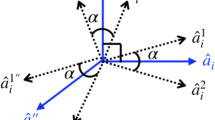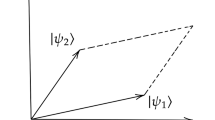No Heading
We derive two complementarity relations that constrain the individual and bipartite properties that may simultaneously exist in a multi-qubit system. The first expression, valid for an arbitrary pure state of n qubits, demonstrates that the degree to which single particle properties are possessed by an individual member of the system is limited by the bipartite entanglement that exists between that qubit and the remainder of the system. This result implies that the phenomenon of entanglement sharing is one specific consequence of complementarity. The second expression, which holds for an arbitrary state of two qubits, pure or mixed, quantifies a tradeoff between the amounts of entanglement, separable uncertainty, and single particle properties that are encoded in the quantum state. The separable uncertainty is a natural measure of our ignorance about the properties possessed by individual subsystems, and may be used to completely characterize the relationship between entanglement and mixedness in two-qubit systems. The two-qubit complementarity relation yields a useful geometric picture in which the root mean square values of local subsystem properties act like coordinates in the space of density matrices, and suggests possible insights into the problem of interpreting quantum mechanics.
Similar content being viewed by others
References
1. J. A. Wheeler and W. H. Zurek, eds., Quantum Theory and Measurement (Princeton University Press, Princeton, 1983).
2. B. Schumacher, Phys. Rev. A 54, 2614 (1996).
3. M. A. Nielsen and I. L. Chuang, Quantum Computation and Quantum Information (Cambridge University Press, Cambridge, 2000).
4. A. K. Ekert, Phys. Rev. Lett. 67, 661 (1991).
5. N. Bohr, Nature 121, 580 (1928).
6. N. Bohr, “Discussion with Einstein on epistemological problems in atomic physics,” in Quantum Theory and Measurement, edited by J. A. Wheeler and W. H. Zurek (Princeton University Press, Princeton, 1983).
7. W. Heisenberg, “The physical content of quantum kinematics and mechanics,” in Quantum Theory and Measurement, edited by J. A. Wheeler and W. H. Zurek (Princeton University Press, Princeton, 1983).
8. G. Jaeger, M. A. Horne, and A. Shimony, Phys. Rev. A 48, 1023 (1993).
9. G. Jaeger, A. Shimony, and L. Vaidman, Phys. Rev. A 51, 54 (1995).
10. B.-G. Englert, Phys. Rev. Lett. 77, 2154 (1996).
11. B.-G. Englert and J. A. Bergou, Opt. Commun. 179, 337 (2000).
12. M. O. Scully and M. S. Zubairy, Quantum Optics (Cambridge University Press, Cambridge, 1997).
13. A. F. Abouraddy, M. B. Nasr, B. E. A. Saleh, A. V. Sergienko, and M. C. Teich, Phys. Rev. A 63, 063803/1 (2001).
14. S. Durr, T. Nonn, and G. Rempe, Phys. Rev. Lett. 81, 5705 (1998).
15. P. D. D. Schwindt, P. G. Kwiat, and B.-G. Englert, Phys. Rev. A 60, 4285 (1999).
16. G. Jaeger, A. V. Sergienko, B. E. A. Saleh, and M. C. Teich, Phys. Rev. A 68, 022318/1 (2003).
17. M. Jakob and J. A. Bergou, “Quantitative complementarity relations in bipartite systems,” unpublished, arXiv.org e-print quant-ph/0302075.
18. V. Coffman, J. Kundu, and W. K. Wootters, Phys. Rev. A. 61, 052306/1 (2000).
19. G. Vidal, J. Mod. Opt. 47, 355 (2000).
20. P. Rungta and C. M. Caves, Phys. Rev. A 67, 012307/1 (2003).
21. W. K. Wootters, Quantum Inf. Comput. 1, 27 (2001).
22. W. K. Wootters, Phys. Rev. Lett. 80, 2245 (1998).
23. K. Zyczkowski, P. Horodecki, A. Sanpera, and M. Lewenstein, Phys. Rev. A 58, 883 (1998).
24. S. Ishizaka and T. Hiroshima, Phys. Rev. A 62, 022310/1 (2000).
25. F. Verstraete, K. Audenaert, and B. De Moor, Phys. Rev. A 64, 012316/1 (2001).
26. W. J. Munro, D. F. V. James, A. G. White, and P. G. Kwiat, Phys. Rev. A 64, 030302(R)/1 (2001).
27. T.-C. Wei, K. Nemoto, P. M. Goldbart, P. G. Kwiat, W. J. Munro, and F. Verstraete, Phys. Rev. A 67, 022110/1 (2003).
28. G. Adesso, F. Illuminati, and S. De Siena, Phys. Rev. A 68, 062318/1 (2003).
29. S. Bose and V. Vedral, Phys. Rev. A 61, 040101/1 (2000).
30. A. Ekert and P. L. Knight, Am. J. Phys. 63, 415 (1995).
31. W. Dur, G. Vidal, and J. I. Cirac, Phys. Rev. A 62, 062314/1 (2000).
32. P. Rungta, V. Buzek, C. M. Caves, H. Hillery, and G. J. Milburn, Phys. Rev. A 64, 042315/1 (2001).
33. M. Lewenstein and A. Sanpera, Phys. Rev. Lett. 80, 2261 (1998).
34. R. F. Werner, Phys. Rev. A 40, 4277 (1989).
35. A. Peres, Phys. Rev. Lett. 77, 1413 (1996).
36. C. E. Shannon and W. Weaver, The Mathematical Theory of Communication (The University of Illinois Press, Urbana, 1962).
37. E. T. Jaynes, “Probability in quantum theory,” Workshop on Complexity, Entropy, and the Physics of Information (1989).
38. G. M. D’Ariano, Fortschr. Phys. 51, 318 (2003).
39. C. M. Caves, C. A. Fuchs, and R. Schack, Phys. Rev. A 65, 022305/1 (2002).
40. J. von Neumann, “Measurement and reversibility and the measuring process,” in Quantum Theory and Measurement, edited by J. A. Wheeler and W. H. Zurek (Princeton University Press, Princeton, 1983).
41. R. Landauer, Phys. Today 44, 23 (1991).
42. A. Einstein, B. Podolsky, and N. Rosen, Phys. Rev. 47, 777 (1935).
Author information
Authors and Affiliations
Corresponding author
Rights and permissions
About this article
Cite this article
Tessier, T. Complementarity Relations for Multi-Qubit Systems. Found Phys Lett 18, 107–121 (2005). https://doi.org/10.1007/s10702-005-3956-4
Received:
Published:
Issue Date:
DOI: https://doi.org/10.1007/s10702-005-3956-4




